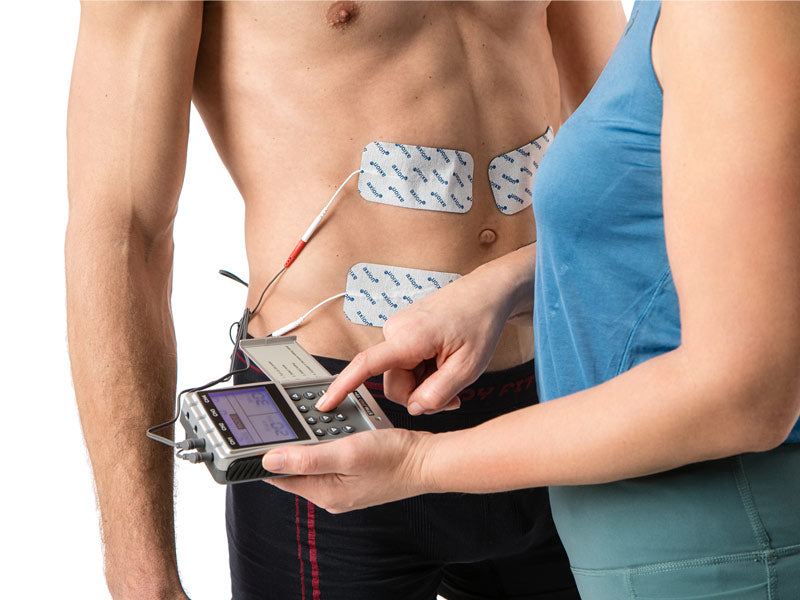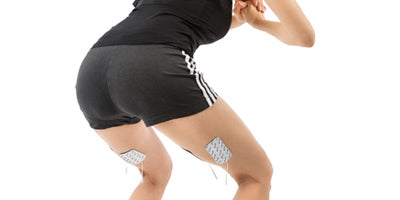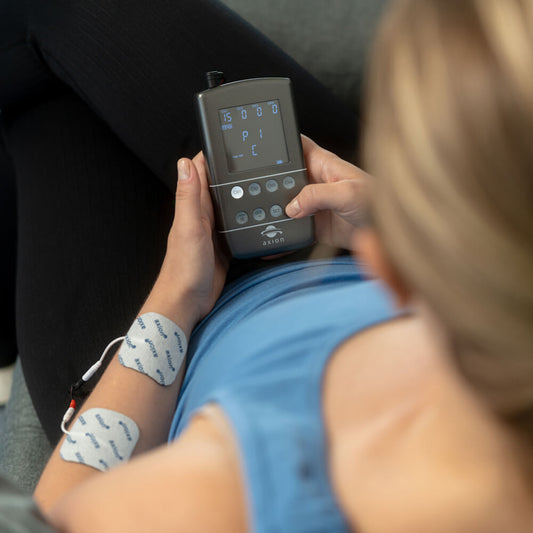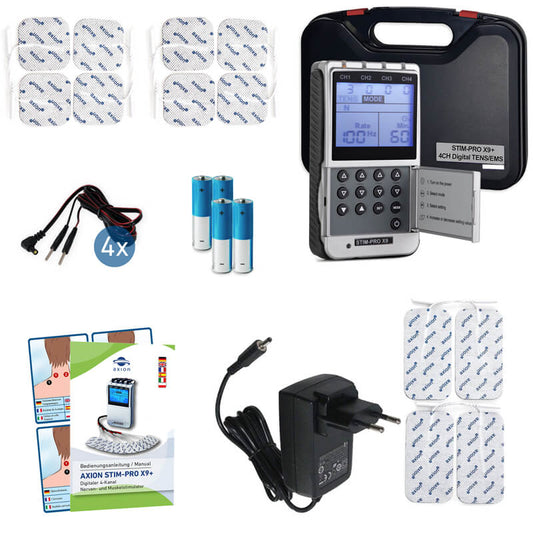EMS devices
Our EMS machine with 4 channels
-
4 Channel TENS EMS machine STIM-PRO X9B with rechargeable battery and soft case
Regular price €164,95Regular priceUnit price per -
TENS EMS machine STIM-PRO X9+
Regular price €164,95Regular priceUnit price per
What is an EMS machine?
An EMS unit is a handy stimulation current device that generates electrical impulses and transfers them to the skin via self-adhesive EMS electrodes. EMS stands for electrical muscle stimulation and can promote muscle strength, blood circulation and muscle regeneration. In short: the effectiveness of your training is increased [1].
EMS devices are used by athletes, physiotherapists, fitness enthusiasts or even by people who have difficulties in carrying out sporting activities on a regular basis.
The aim of EMS training is to improve performance, accelerate muscle regeneration, reduce muscle pain, promote body fat loss [2], prevent muscle loss due to injuries and increase general physical fitness

Muscle stimulation at home
How does an EMS device work?
EMS devices use electrical impulses to create the muscle contractions normally induced by physical activity or training.
The alternation of tensing ( contraction ) and relaxing ( relaxation ) causes strain and fatigue on the muscles. Our body reacts to the exhaustion of the muscles with muscle growth in order to better withstand such a load in the future.
The way our body reacts to building muscle does not change with the way you train, but with EMS training you can make muscle building more efficient , more targeted and easier on the joints.

How does training with an EMS device feel?
If you use an EMS device, the programs usually consist of alternating on (electrical impulse is delivered) and off sequences (no electrical impulse is delivered).
The user can adjust the intensity of the impulses to suit his or her body part and fitness level, making EMS training suitable for both inexperienced and professional athletes .
Which muscle groups can be trained with EMS
In addition to the time-saving effect and the cost-effectiveness compared to training in an EMS studio, the versatility of the training options is another major advantage of using an EMS device.
You can train almost every muscle group without any additional equipment and from the comfort of your own home or on the go. With the STIM-PRO X9, you have 14 pre-installed training programs at your disposal, and you can also put together your own training program by freely setting the parameters.
We have electrode placement and program recommendations for a variety of EMS applications on our EMS overview page, including for these muscle groups:
-

Upper body
Belly
Upper back
Lower back
-

Legs
Gluteus maximus
Quadriceps
Calves
-

Arms
Shoulders
Biceps
Triceps
Frequently asked questions
FAQ EMS
What does the EMS training process look like?
- A Place the electrodes on the muscle you want to train
- Connect the electrodes to the EMS device
- Choose the right program
- To start, change the intensity (your muscle should contract significantly without feeling pain)
Are there any restrictions or contraindications for EMS training?
Yes, there are. In the case of the following contraindications, you should consult your doctor before using EMS, as he can tell you whether EMS training is suitable for you based on his knowledge of your state of health.
- Heart problems, such as an abnormal heart rhythm or wearing a pacemaker
- pregnancy
- epilepsy
- Skin problems in the application area
- cancers
- Stronger sensory disturbances in the application area
- Acute injuries (eg open wounds) or severe local inflammation
Which muscles can you train with EMS?
With EMS you can train every muscle and also the deep muscles. You can find out more about this in the overview of EMS applications
Do you need special clothing or equipment for EMS training?
Not with our devices.
EMS studios often work with suits or cuffs in which the electrodes are integrated.
With EMS devices for use at home, you can apply the adhesive electrodes to the desired part of the body and start training.
How long does an EMS training session last?
It all depends on whether you're training the whole body or just specific muscle groups.
In combination with classic exercises, 20-30 minutes is usually enough for the training session, since the intensity of the training increases with EMS.
How much do EMS devices cost?
Depending on the version, EMS devices can cost between fifty and several thousand euros. For home use, the devices are usually cheaper than for studio use, which is usually related to the channels.
In addition to the device, there are also costs for the adhesive electrodes with our devices and for studio devices usually a suit or special clothing.
How often should you do EMS training?
Many advertise with the statement that one EMS training per week is sufficient. However, this depends on many factors, such as personal goals or the type of training.
It is only important to take enough breaks between the EMS training sessions so that the muscle can regenerate.
In general, it is advisable to do strength training regularly. For several years now, the World Health Organization (WHO) has also included strength training in its recommendations for physical activity. This states that adults (including those over the age of 65) should do strength training at least twice a week to strengthen their muscles[3]. It doesn't matter whether it's at home or in the gym.
Are EMS devices safe?
When used correctly and with medically certified devices, such as our axion EMS devices, they are safe.
Pay attention to the information in the instructions for use and always start with a low intensity and slowly feel your way forward.
For whom are EMS devices suitable?
EMS training is particularly suitable for sports enthusiasts and athletes, but also for anyone who has little time for regular physical activity or wants to maintain muscles.
An EMS device is also useful after injuries, as the muscles surrounding the injury can be trained without straining the injured area.
-

-
We are happy to help
Do you still have questions about EMS machines? Our trained consultants are there for you!
-
Give us a call:
+49 (0) 7152 - 353 911 - 0
Mon-Fri, 09:00 - 17:00
Send us an email:
customerservice@axion.shop
Collapsible content
Studies and scientific sources
[1] Prof. Dr. Kemmler von der Universität Erlangen-Nürnberg beantwortet die wichtigsten Fragen zum EMS-Training. (2017). newsystEMS. https://www.newsystems.online/wissenschaft/prof-dr-kemmler-von-der-universitaet-erlangen-nuernberg-beantwortet-die-wichtigsten-fragen-zum-ems-training/
[2] Boeckh-Behrens W, Treu S (2002) Vergleich der Trainingseffekte von konventionellem Training, maxxF und EMS-Training in den Bereichen Körperzusammensetzung, Körperformung, Kraftentwicklung, Psyche und Befindlichkeit. Sportwissenschaft Universität Bayreuth, 2002. Nicht veröffentlicht. Online verfügbar: https://www.speed-fit.de/download/pdf/studien/studie_03.pdf
[3] World Health Organization. (2010). Global recommendations on physical activity for health. World Health Organization. Online verfügbar: https://www.who.int/dietphysicalactivity/global-PA-recs-2010.pdf











